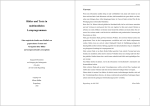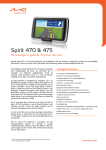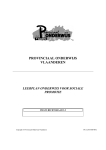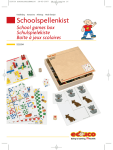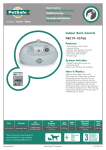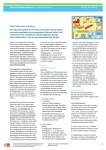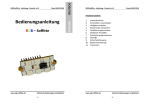Download Panorama
Transcript
HANDLEIDING PANORAMA Handleiding 27-03-2007 Instructions Anleitung Panorama 522.033 12:29 Pagina 6 Mode d’emploi HANDLEIDING PANORAMA 27-03-2007 12:28 Pagina 1 Panorama Leerdoelen - ontwikkeling van de visuele waarneming - stimuleren van de taal-denkontwikkeling (verwoorden, rubriceren, associëren) - ontwikkeling van de woordenschat - sociale ontwikkeling (samenwerken, overleggen) Inhoud - 6 matrixborden - 6 x 16 begrippenkaartjes Opbouw van het spel Hierbij nemen we het 'groot-klein panorama' als voorbeeld. Bij de eerste kennismaking van het materiaal kan de leerkracht naar aanleiding van de opmerkingen van de kinderen, vragen de kaartjes te sorteren; naar vorm of grootte. Bijvoorbeeld: Leg alle pakjes bij elkaar. In dezelfde les kan nog worden overgegaan tot combinatie van deze twee eigenschappen. Bijvoorbeeld: Leg een rij van paddestoelen, de kleinste voorop. Daarna introduceert u het matrixbord. Hierop staat horizontaal, in kleur de opdracht gedrukt en verticaal, de afbeeldingen van de voorwerpen die het kind moet ordenen. Om de kinderen niet met teveel informatie ineens te overstelpen, lijkt het ons verstandig dat u de diverse 'panorama's' op verschillende tijdstippen introduceert. De volgorde van introductie kunt u zelf bepalen. Onderwerpen 1. Ordening naar inhoud 1/4 vol, 1/2 vol, 3/4 vol, vol 2. Kleuren ordening naar kleurvolgorde 3. Positie ordening naar plaats in de ruimte. links, rechts, voor, achter 4. Dun - dik ordening naar dikte van dun naar dik 5. Laag - hoog ordening naar plaats in de ruimte, ordening naar lengte, ordening van laag naar hoog 6. klein - groot ordening naar grootte van klein naar groot HANDLEIDING PANORAMA 27-03-2007 12:28 Pagina 2 Panorama Learning goals: - Development of visual perception - Stimulating linguistic-cognitive development (using words, categorising, associating) - Vocabulary development - Social development (cooperating, consulting) Contents - 6 matrix boards - 6 x 16 concept cards Structure of game Here we use the ”large-small panorama” as an example. The first time the material is introduced, the teacher can ask the children to sort the cards according to shape or size, in response to children’s comments. For example: Place all the packages together. In the same lesson, you can proceed to use a combination of these characteristics. For example: Place a row of mushrooms, with the smallest first. Then introduce the matrix board. This shows the task printed in colour horizontally and the pictures of the objects the child must arrange vertically. So as not to overwhelm the children with too much information at once, we think it is a good idea to introduce various ”panoramas” at different times. You can decide what order you introduce them in. Subjects 1. Arrangement according to contents 1/4 full, 1/2 full, 3/4 full, full 2. Colour arrangement In order of colour 3. Position Arrangement according to position in space Left, right, front, back 4. Thin-thick Arrangement according to thickness From thin to thick 5. Low-high arrangement according to position in space Arrangement according to length, Arrangement from low to high 6. Small-large Arrangement according to size From small to large HANDLEIDING PANORAMA 27-03-2007 12:28 Pagina 3 Panorama Lehrziele - Entwicklung der visuellen Wahrnehmung - Stimulation der Sprach-Denkentwicklung (verbal ausdrücken, einordnen, assoziieren) - Entwicklung des Wortschatzes - Soziales Verhalten (zusammenarbeiten, überlegen) Inhalt - 6 Matrix Karten - 6 x 16 Koncept Karten Aufbau des spieles Hierbei nehmen wir das „Groß-klein Panorama“ zum Vorbild. Beim ersten Kennenlernen des Materials kann die Lehrkraft auf die Bemerkungen der Kinder hin diese darum bitten, die Karten zu sortieren und zwar nach Form oder Größe. Beispiel: Lege alle Päckchen zusammen. In derselben Stunde kann noch zur Kombination dieser zwei Eigenschaften übergegangen werden. Beispiel: Lege eine Reihe mit Pilzen und beginne mit den kleinsten. Danach stellen Sie die Matrixtafel vor. Hierauf befindet sich horizontal und in Farbe der Auftrag und vertikal die Abbildungen der Gegenstände, die das Kind ordnen muss. Damit die Kinder nicht mit zu vielen Informationen auf einmal überhäuft werden, erscheint es uns sinnvoll, wenn Sie verschiedene „Panoramen“ zu unterschiedlichen Zeitpunkten vorstellen. Die Reihenfolge der Vorstellung können Sie selbst bestimmen. Gegenstände 1. Ordnen nach Inhalt 1/4 voll, 1/2 voll, 3/4 voll, voll 2. Farben ordnen nach Farbreihenfolge 3. Position Ordnen nach Lage im Raum links, rechts, vorne, hinten 4. Dünn-dick Ordnen nach Dicke Von dünn nach dick 5. Ordnen niedrig-hoch Ordnen nach Lage im Raum Ordnen nach Länge, Ordnen von niedrig nach hoch 6. Klein-Groß Ordnen nach Größe Von klein nach groß HANDLEIDING PANORAMA 27-03-2007 12:28 Pagina 4 Panorama Objectifs éducatifs: - développement de la perception visuelle - stimulation du développement du langage en relation avec le raisonnement (formulation, classification, association) - enrichissement du vocabulaire - socialisation (esprit d’équipe, concertation) Contenu - 6 plateaux matriciels - 6 x 16 cartes conceptuelles Déroulement du jeu Ce jeu repose sur le principe du « panorama grand-petit ». Lorsque les enfants découvrent le jeu pour la première fois, l’enseignant peut, en fonction des remarques des enfants, leur demander de classer les cartes en fonction de leur forme ou de leur dimension. Par exemple: Regrouper tous les colis ensemble. L’enseignant peut demander aux enfants, au cours de la même leçon, de procéder à une classification selon ces deux caractéristiques. Par exemple: Faites un rang de champignons en partant du plus petit. Introduisez ensuite le plateau matriciel. La mission figure en couleur à l’horizontale, tandis qu’une représentation des sujets que l’enfant doit classer figure à la verticale du plateau matriciel. Pour ne pas submerger les enfants d’informations, nous vous conseillons d’introduire les divers « panoramas » de manière progressive. A vous de décider de l’ordre d’introduction. Sujets 1. Classification en fonction de la contenance rempli à un 1/4, rempli à la 1/2, rempli aux 3/4, rempli 2. Classification en fonction de la couleur selon l’ordre des couleurs 3. Position classification en fonction de la position dans l’espace gauche, droite, devant, derrière 4. Epais-fin Classification en fonction de l’épaisseur du plus fin au plus épais 5. Classification en fonction de la hauteur « bas-haut » en fonction de la position dans l’espace, classification en fonction de la longueur, classification en fonction de la hauteur 6. petit-grand classification en fonction de la grandeur du plus petit au plus grand HANDLEIDING PANORAMA 27-03-2007 12:28 Pagina 5 Heutink Nijverheidsstraat 45 7461 AD Rijssen Holland tel.: +31(0)548 53 66 00 www.educo.nl [email protected]






